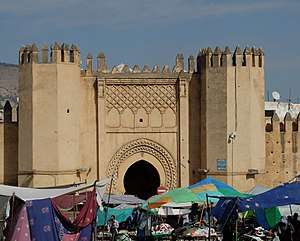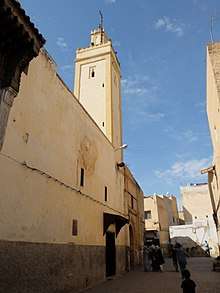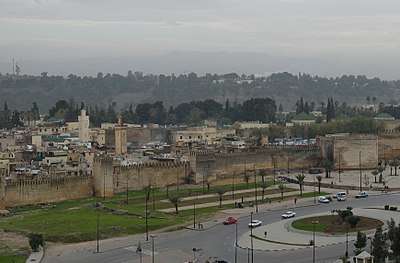Kasbah An-Nouar

The Kasbah An-Nouar (variant spellings: Kasbah en-Nouar, Kasbah Nouar, etc.) is a walled district and former military enclosure in the old medina of Fez, Morocco. Its name means "citadel of the flowers", but it is sometimes also referred to as Kasbah Filala and Kasbah Chorfa.[1] It is one of several fortified military enclosures or kasbahs that were built around the old city of Fez across different periods.
History

The foundation of the kasbah reportedly dates to the Almohad period when Muhmmad al-Nasir (12th century) rebuilt the fortifications of Fez.[1][2] It is likely that it took its present form, however, during the Alaouite period,[3][4] when it acquired its association with the Filala (settlers from the Tafilalt region)[1].
Medieval period (12th century to 16th century)
The Almohads under Abd al-Mu'min conquered Fez in 1145 after a difficult siege in which the inhabitants had put up fierce resistance. In retaliation for this opposition and to prevent future resistance, Abd al-Mu'min ordered all the walls and fortifications of Fez to be demolished.[5] Eventually, however, given the city's central economic importance and its role as a military base for northern Morocco, the fourth Almohad Caliph, Muhammad al-Nasir (1199–1213), built a new circuit of city walls as well as two citadels or kasbahs in the west of the city. One kasbah was the Kasbah en-Nouar, erected in an area adjacent to the western gate of Bab al-Mahrouk (which was also built at this time).[1][5] The other, Kasbah Bou Jeloud, was built to the south on the site of the former Almoravid citadel, near Bab Bou Jeloud, and was in more than one period the residence of the governor of Fez (including at the beginning of the 20th century).[3] The decision to fortify the city at this time was likely also due to the Almohads' serious defeat at the Battle of Las Navas de Tolosa the same year, which rendered the empire more vulnerable.[5]
The Marinids, who succeeded the Almohads in the 13th century and made Fez their capital and residence, found the existing military citadels insufficient for their own purposes, and built the new palace-city of Fes el-Jdid to the west, just outside the old city (Fes el-Bali).[5] When Morocco was taken over by the Saadian dynasty (16th-17th centuries) the capital was again moved to Marrakech, while the Saadians built new fortresses (among them Borj Nord) to keep Fez under control.[5]
Alaouite period (17th century to present)
The first Alaouite sultan, Moulay Rachid (1664–1672), turned Fez into the capital of his new kingdom. The Alaouite sharifs (descendants of the Prophet Muhammad) had been based in the eastern oasis region of Tafilalt before they conquered the country, and consequently Moulay Rachid was followed by many people from that region as he gained power. The Kasbah en-Nouar was consequently given over to settlers from the Tafilalt and acquired the name Kasbah Filala (meaning "Citadel of the people from Tafilalt"; Filala being the corresponding demonym).[1]Moulay Rachid also built the nearby Kasbah Cherarda to house guich tribes.[6]
The kasbah's walls and its Friday mosque were restored under the later Alaouite sultan Moulay Slimane (1792–1822).[1][7] The kasbah's main gate, Bab Chorfa, also reportedly dates from the Alaouite period in its current form.[3][4]
Community and self-governance in the Alaouite period
Historically during this period, the community inside the kasbah was self-governed (instead of governed by officials of the central government), electing its own council of 12 elders who in turn designated a chief, a secretary and a treasurer.[3] These leaders were in charge of managing the neighbourhood's services and infrastructure, which could be maintained thanks to specially reserved revenues under waqf (trust) agreements. These included, for example, the revenues of various shops and rented housing.[3] This self-governance reflects the fact that, up until at least the 20th century, the kasbah was inhabited strictly by families of Filali (Tafilalt) origin, and this system likely reflected practices of local governance that existed in the Tafilalt.[3] Among them were also many sharifian families of the Alaouite extended family (also of Filali origin, as mentioned).[3][1] (This may be the reason for the name of its gate, Bab Chorfa, shurafa being the plural of Arabic sharif.) Entry to the kasbah was even forbidden to outsiders, which may be more or less still true today.[1][3]

Description
The Kasbah (citadel) is located at the western or north-western tip of Fes el-Bali, between Bab Bou Jeloud (the main western entrance to the old medina) and Bab Mahrouk. It is enclosed by tall fortified walls and closed off from the rest of the medina: the main city walls of Fes el-Bali run along its northwestern side, while another wall curtails it on its eastern and southern sides.[3]
Its only entry point is Bab Chorfa, a monumental gate that opens from Place Bou Jeloud (Bou Jeloud Square; also known as Place Pacha el-Baghdadi or Place Baghdadi).[8] The gate is flanked by two strong octagonal towers and is decorated with carved patterns. Inside the gate the passage is bent at straight angles and composed of several sequential chambers.[5][3] Inside the towers are a dozen chambers which historically could be rented out to contribute to the revenues of the community.[3]
Inside the walls, the kasbah today is a residential district packed with houses and winding alleys, much like the rest of the medina. Just north of the entrance, near the beginning of the kasbah's main street, is a Friday mosque, flanked by a small public square. Its minaret is fairly prominent and easily visible from outside the kasbah, and its main portal off the square. The date and origin of the mosque is uncertain, but likely coincides with the kasbah's foundation, which may make it an Almohad foundation as well, later restored under the Alaouites.[3][1]
Outside the kasbah, in front of Bab Chorfa, is a local but extensive open-air market that has taken place here for generations.[9]
References
| Wikimedia Commons has media related to Kasbah An-Nouar. |
- 1 2 3 4 5 6 7 8 9 Gaudio, Attilio (1982). Fès: Joyau de la civilisation islamique. Paris: Les Presses de l'Unesco: Nouvelles Éditions Latines. pp. 72–73. ISBN 2723301591.
- ↑ Gaillard, Henri (1905). Une ville de l'Islam: Fès. Paris: J. André. p. 109.
- 1 2 3 4 5 6 7 8 9 10 11 12 Le Tourneau, Roger (1949). Fès avant le protectorat : étude économique et sociale d'une ville de l'occident musulman. Casablanca: Société Marocaine de Librairie et d'Édition. pp. 74, 84, 107–108, 188, 265–266.
- 1 2 Parker, Richard (1981). A practical guide to Islamic Monuments in Morocco. Charlottesville (Ca.): Baraka Press.
- 1 2 3 4 5 6 Métalsi, Mohamed (2003). Fès: La ville essentielle. Paris: ACR Édition Internationale. pp. 18–19, 36–37, 273, 297. ISBN 978-2867701528.
- ↑ Métalsi, Mohamed (2003). Fès: La ville essentielle. Paris: ACR Édition Internationale. pp. 294, 296. ISBN 978-2867701528.
- ↑ Rogerson, Barnaby (2000). Marrakesh, Fez, Rabat. London: Cardogan Guides. p. 167. ISBN 1860119735.
- ↑ The Rough Guide to Morocco. London: Rough Guides. 2016. ISBN 9780241236680.
- ↑ Le Tourneau, Roger (1949). Fès avant le protectorat: étude économique et sociale d'une ville de l'occident musulman. Casablanca: Société Marocaine de Librairie et d'Édition. p. 395.